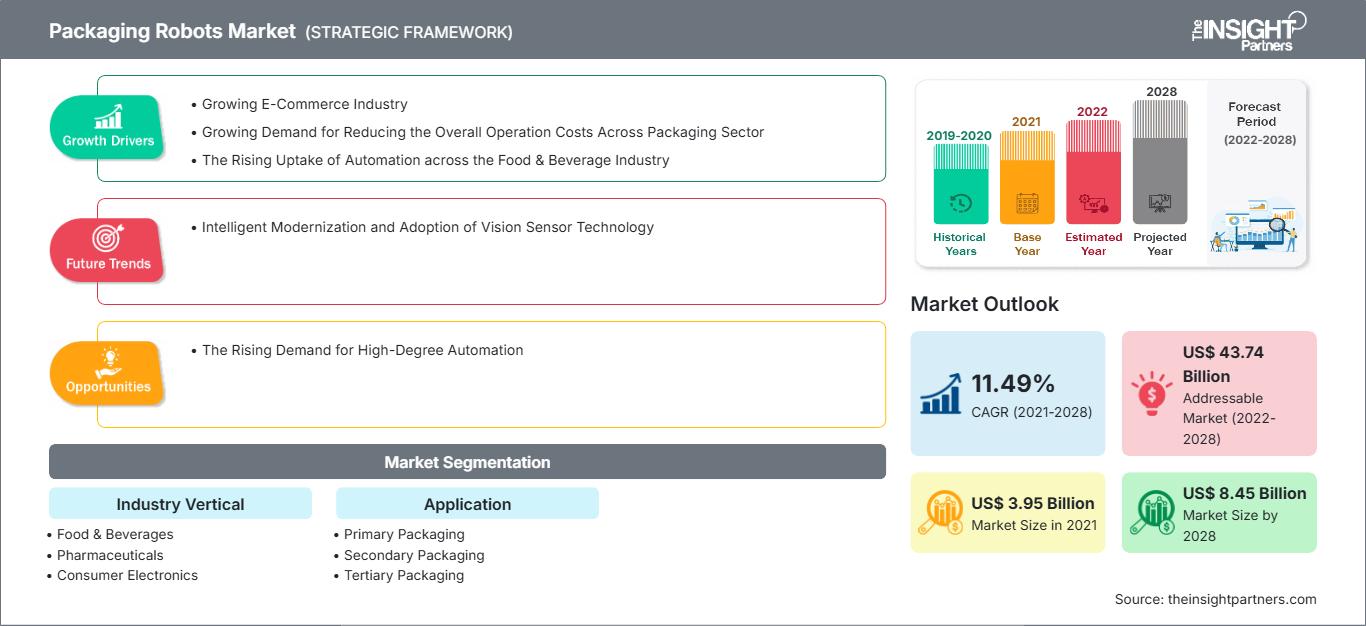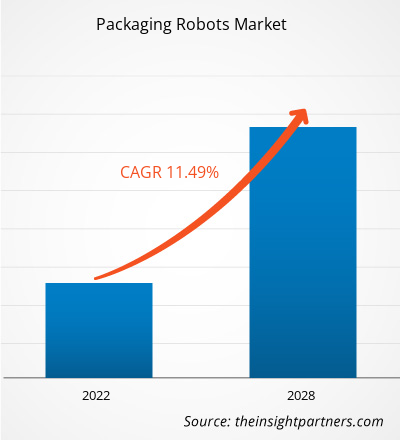[Forschungsbericht] Der Markt für Verpackungsroboter soll von 3.945,43 Millionen US-Dollar im Jahr 2021 auf 8.448,21 Millionen US-Dollar im Jahr 2028 wachsen; die durchschnittliche jährliche Wachstumsrate (CAGR) liegt zwischen 2021 und 2028 bei 11,49 %.
Analystenperspektive:
Verpackungsroboter steigern Genauigkeit, Geschwindigkeit und Produktivität im Materialhandhabungsprozess. Aus diesem Grund setzen verschiedene Hersteller Verpackungsroboter ein, um ihren Durchsatz zu steigern. Da Verpackungsroboter zudem mehr Produkte gleichzeitig heben können, bieten sie deutlich höhere Betriebszeiten als manuelle Arbeitskräfte und senken die Arbeitskosten sowie den Gesamtbetrieb, was das Wachstum des Marktes für Verpackungsroboter fördert. Darüber hinaus treibt der zunehmende Einsatz kollaborativer Roboter in der Lebensmittel- und Getränkeindustrie, die Hunderte von Verpackungen und Flaschen befüllen und andere komplexe Aufgaben effizienter als Menschen erledigen, das Wachstum des Marktes für Verpackungsroboter voran. Auch der weltweit wachsende E-Commerce-Markt trägt zum Wachstum des Marktes für Verpackungsroboter bei. Darüber hinaus wird erwartet, dass die steigende Nachfrage nach hochgradiger Automatisierung im Prognosezeitraum Wachstumschancen für den Markt für Verpackungsroboter bietet.
Marktübersicht:
Verpackungsroboter sind Roboter, die so programmiert sind, dass sie sich entlang einer vordefinierten Route bewegen, um Objekte aus verschiedenen Lagerorten aufzunehmen und in Regale zu legen. Diese Roboter arbeiten ohne menschliches Eingreifen und können Zeit sparen, indem sie die Produktionslinie rationalisieren und den Bedarf an überflüssigen menschlichen Eingriffen reduzieren. Sie bieten viele wichtige Vorteile in verschiedenen Industriezweigen, indem sie Geschwindigkeit, Genauigkeit und Produktivität steigern und bei richtiger Anwendung einen relativ schnellen Return on Investment (ROI) erzielen. Abhängig vom End-of-Arm-Tooling (EOAT) können Verpackungsroboter viele verschiedene Aufgaben erledigen. Verpackungsroboter dienen in der Regel zum Öffnen, Befüllen, Transportieren, Palettieren, Verschließen, Kennzeichnen und Etikettieren von Produktverpackungen. Aufgrund der oben genannten Vorteile werden sie vor allem in Branchen eingesetzt, in denen Produkte präzise, konsistent und hochwertig verpackt werden müssen, um die Produktintegrität zu gewährleisten. Im Industriesektor werden Verpackungsroboter häufig eingesetzt, um Zykluszeiten zu verkürzen und die Produktivität zu steigern, während die Lebensmittel- und Getränkeindustrie Verpackungsroboter aus ähnlichen Gründen einsetzt.
Passen Sie diesen Bericht Ihren Anforderungen an
Sie erhalten kostenlos Anpassungen an jedem Bericht, einschließlich Teilen dieses Berichts oder einer Analyse auf Länderebene, eines Excel-Datenpakets sowie tolle Angebote und Rabatte für Start-ups und Universitäten.
Markt für Verpackungsroboter: Strategische Einblicke

-
Holen Sie sich die wichtigsten Markttrends aus diesem Bericht.Dieses KOSTENLOSE Beispiel umfasst Datenanalysen, die von Markttrends bis hin zu Schätzungen und Prognosen reichen.
Markttreiber für Verpackungsroboter:
Die zunehmende Automatisierung in der Lebensmittel- und Getränkeindustrie treibt das Wachstum des Marktes für Verpackungsroboter voran.
Automatisierung in der Lebensmittel- und Getränkeindustrie bezieht sich auf die Integration von Technologien in verschiedene Produktionsprozesse wie Inspektion, Verpackung und Lagerung. Im Laufe der Jahre haben Lebensmittel- und Getränkeunternehmen verschiedene Produktionsprozesse durch die Integration automatisierter Systeme wie fahrerloser Transportfahrzeuge, Delta-Roboter und Roboterarme optimiert, um den von verschiedenen Aufsichtsbehörden festgelegten Lebensmittelsicherheits- und Qualitätsstandards zu entsprechen und die Gesamtarbeitskosten an allen Produktionsstandorten zu senken.
Darüber hinaus erfordern verpackte Lebensmittel und Getränke eine hohe Genauigkeit und sich wiederholende Verpackungsprozesse, was eine Herausforderung für den Menschen darstellt. Dieser Faktor erhöht die Nachfrage nach Robotertechnologien für verschiedene Tätigkeiten, einschließlich Primär- und Sekundärverpackung sowie Palettierung.
Außerdem erfreuen sich bildgeführte Roboter einer steigenden Nachfrage in der Lebensmittel- und Getränkebranche aufgrund ihrer Effizienz bei der Erledigung verschiedener sich wiederholender Aufgaben wie Bin Picking, Flaschenhandling und Tray-Beladung. Darüber hinaus haben zahlreiche Vorteile, darunter verbesserte Effizienz, verbesserte Rückverfolgbarkeit und hohe Flexibilität, den Bedarf an Automatisierung in der Lebensmittel- und Getränkeindustrie erhöht. Solche Faktoren ermutigen Lebensmittel- und Getränkehersteller, ihre Investitionen in die Integration automatisierter Technologien in ihren Produktionsanlagen zu erhöhen. So kündigte beispielsweise Utz Brands Inc., eine US-amerikanische Snackmarke, im Jahr 2021 Pläne an, automatisierte Lösungen in all ihren Produktionsanlagen zu integrieren, um die Gesamtbetriebskosten zu senken. Ebenso kündigte Hormel Foods im Jahr 2022 Pläne an, Automatisierung in all seinen Produktionsanlagen zu integrieren. Andere Lebensmittel- und Getränkemarken wie Tyson Foods und Cargill Inc. arbeiten ebenfalls an der Einführung automatisierter Technologien. Daher sind die steigenden Investitionen in Automatisierung in der Lebensmittel- und Getränkebranche Die Getränkeindustrie treibt das Wachstum des Marktes für Verpackungsroboter voran.
Segmentanalyse:
Basierend auf der Branchenvertikale ist der Markt für Verpackungsroboter in Lebensmittel und Getränke, Pharmazeutika, Unterhaltungselektronik und Sonstiges unterteilt. Das Segment Lebensmittel und Getränke hatte 2021 den größten Marktanteil, während für das Segment Pharmazeutika zwischen 2021 und 2028 die höchste durchschnittliche jährliche Wachstumsrate erwartet wird. Die Lebensmittel- und Getränkeindustrie erlebt eine rasante Integration von Automatisierungslösungen. Verpackungsroboter ermöglichen schnelleres Verpacken bei gleichzeitiger Gewährleistung der Qualitätskontrolle. Die Integration von Verpackungsrobotern erhöht zudem die Arbeitssicherheit, und die lückenlose Rückverfolgbarkeit steigert den Ausstoß, reduziert Abfall und senkt die Arbeitskosten, wodurch die Produktion flexibler wird. Aufgrund dieser Vorteile arbeiten verschiedene Lebensmittelunternehmen an der Optimierung ihrer Prozesse mithilfe von bildverarbeitungsgesteuerten Roboterarmen, fahrerlosen Transportsystemen, Delta-Robotern und fortschrittlichen Inspektionssystemen, um Lebensmittelsicherheit und Qualitätsstandards zu gewährleisten und die stetig wachsende Nachfrage zu erfüllen. Somit treibt die zunehmende Automatisierung in der Lebensmittel- und Getränkeindustrie zur Modernisierung der bestehenden Infrastruktur das Marktwachstum an.
Regionale Analyse:
Im asiatisch-pazifischen Raum wird im Prognosezeitraum ein deutliches Wachstum des Marktes für Verpackungsroboter erwartet. In der Region wird China im Jahr 2021 den größten Marktanteil halten, während Indien zwischen 2021 und 2028 die höchste durchschnittliche jährliche Wachstumsrate (CAGR) verzeichnen wird. Die steigenden Investitionen in Automatisierung zur Verbesserung der Produktivität und Senkung der Kosten helfen den Herstellern, die steigenden Verbraucheranforderungen zu erfüllen. Da die Integration von Robotern außerdem die Verpackungseffizienz verbessert und die Betriebskosten senkt, steigt die Nachfrage nach Robotern in verschiedenen Branchen. Darüber hinaus wird die Nachfrage nach Automatisierung durch die florierende E-Commerce-Branche in der Region getrieben. Laut der International Air Transport Association (IATA) führt die Region APAC das Wachstum des E-Commerce-Marktes weltweit an, wobei China einen erheblichen Anteil am Wachstum ausmacht. Laut der International Trade Administration ist der chinesische E-Commerce-Markt der größte der Welt und generiert fast 50 % der weltweiten Transaktionen. Auch in anderen Ländern der Asien-Pazifik-Region verzeichnet der E-Commerce-Markt ein deutliches Wachstum. Laut der International Trade Administration beispielsweise wird Australien – der elftgrößte E-Commerce-Markt der Welt – bis 2024 voraussichtlich 32,3 Milliarden US-Dollar erreichen. Laut der India Brand Equity Foundation (IBEF) wird der E-Commerce-Markt in Indien bis 2025 voraussichtlich 188 Milliarden US-Dollar erreichen. Somit treibt die wachsende Automatisierungs- und E-Commerce-Branche das Marktwachstum in der APAC-Region an.
Analyse der wichtigsten Akteure:
ABB Ltd, Brenton Engineering, FANUC Corporation, Krones AG, KUKA Roboter GmbH, Mitsubishi Electric Corporation, Remtec Automation LLC, Robert Bosch GmbH, Schnider Electric und Yaskawa America gehören zu den wichtigsten Akteuren auf dem Markt für Verpackungsroboter. Diese Akteure konzentrieren sich auf kontinuierliche Produktentwicklung und Innovation.
Verpackungsroboter
Regionale Einblicke in den Markt für VerpackungsroboterDie Analysten von The Insight Partners haben die regionalen Trends und Faktoren, die den Markt für Verpackungsroboter im Prognosezeitraum beeinflussen, ausführlich erläutert. In diesem Abschnitt werden auch die Marktsegmente und die geografische Lage in Nordamerika, Europa, dem asiatisch-pazifischen Raum, dem Nahen Osten und Afrika sowie Süd- und Mittelamerika erörtert.
Umfang des Marktberichts zu Verpackungsrobotern
| Berichtsattribut | Einzelheiten |
|---|---|
| Marktgröße in 2021 | US$ 3.95 Billion |
| Marktgröße nach 2028 | US$ 8.45 Billion |
| Globale CAGR (2021 - 2028) | 11.49% |
| Historische Daten | 2019-2020 |
| Prognosezeitraum | 2022-2028 |
| Abgedeckte Segmente |
By Branchenvertikale
|
| Abgedeckte Regionen und Länder |
Nordamerika
|
| Marktführer und wichtige Unternehmensprofile |
|
Dichte der Marktakteure für Verpackungsroboter: Auswirkungen auf die Geschäftsdynamik verstehen
Der Markt für Verpackungsroboter wächst rasant. Die steigende Nachfrage der Endverbraucher ist auf Faktoren wie veränderte Verbraucherpräferenzen, technologische Fortschritte und ein stärkeres Bewusstsein für die Produktvorteile zurückzuführen. Mit der steigenden Nachfrage erweitern Unternehmen ihr Angebot, entwickeln Innovationen, um den Bedürfnissen der Verbraucher gerecht zu werden, und nutzen neue Trends, was das Marktwachstum weiter ankurbelt.

- Holen Sie sich die Markt für Verpackungsroboter Übersicht der wichtigsten Akteure
Neueste Entwicklungen:
Anorganische und organische Strategien wie Produkteinführungen, Partnerschaften, Kooperationen sowie Fusionen und Übernahmen werden von Unternehmen auf dem Markt stark genutzt. Im Folgenden sind einige wichtige Marktentwicklungen dieser Unternehmen aufgeführt:
- Im April 2023 kündigte Shemesh die Einführung der komplett robotergestützten Verpackungslinie TKS-C60 für Kosmetika an, die den gesamten Verpackungsprozess – Zuführung, Abfüllung, Verschließen, Etikettieren, Kartonieren und Palettieren von Kosmetikprodukten aller Formen und Größen – übernimmt. Der TKS-C60 gewährleistet eine nahtlose, unterbrechungsfreie Abfüllanlage für eine Reihe von Produkten, von Cremes und Grundierungen bis hin zu Parfüms und Nagellack, mit einer Geschwindigkeit von 60 Flaschen pro Minute.
- Im März 2023 kündigte Proco Machinery, ein Hersteller von Automatisierungssystemen für die kundenspezifische Abfüll- und Verpackungsindustrie, die Einführung eines neuen kollaborativen Roboterpackers an, um dem wachsenden Arbeitskräftemangel in der Verpackungsindustrie zu begegnen. Dieser neue kollaborative Roboterpacker von Proco ist dafür konzipiert, mit menschlichen Bedienern zusammenzuarbeiten, um Effizienz und Leistung zu steigern. Der neue Roboterpacker kann eine Reihe von Aufgaben ausführen, vom Testen von Behältern bis hin zum Verpacken in Kisten.
- Im Februar 2023 gab Rapid Robotics eine neue Partnerschaft mit Universal Robots (UR) bekannt, im Rahmen derer der dänische Hersteller kollaborativer Roboter (Cobots) kollaborative Roboterarme für den Einsatz von Cobot-Arbeitszellen von Rapid Robotics in ganz Nordamerika liefern wird. Darüber hinaus wird Universal Robots es Rapid Robotics ermöglichen, eine größere Anzahl von Kunden zu bedienen und die gewohnt schnellen Bereitstellungszeiten beizubehalten, auch wenn Rapid Robotics seine nationale Präsenz weiter ausbaut. Diese kollaborativen Roboter verfügen über eine Vielzahl von Fähigkeiten, wie z. B. Palettieren, Kartonbau und -verpackung sowie Vorgänge, die eine höhere Nutzlast oder größere Reichweite erfordern.
- Im November 2022 gab OSARO, ein weltweit führendes Unternehmen im Bereich KI-gesteuerter Robotik für den E-Commerce, eine Partnerschaft mit SVT Robotics bekannt, um die Integration von Pick-and-Place-Robotiksystemen für E-Commerce- und Logistikunternehmen zu beschleunigen. Die bahnbrechende SOFTBOT-Plattform von SVT Robotics ermöglicht es Unternehmen, die benötigten Roboter, Automatisierungs- und IoT-Geräte in nur wenigen Tagen oder Wochen zu integrieren und bereitzustellen. Im Rahmen der Vereinbarung ist SVT Robotics dem Partnerprogramm von OSARO beigetreten, das Unternehmen, die Roboterlösungen in ihren Fulfillment-Abläufen einsetzen möchten, einen zentralen Zugang bietet.
- Im Juli 2022 gab ABB bekannt, dass es sein FlexPicker Delta-Roboterportfolio um den IRB 365 erweitert. Mit fünf Achsen und einer Nutzlast von 1,5 kg ist der IRB 365 sowohl flexibel als auch der schnellste seiner Klasse beim Neuausrichten verpackter leichter Produkte wie Kekse, Schokolade, Paprika, Bonbons, kleiner Flaschen und Pakete. Als Reaktion auf den Anstieg des E-Commerce und die wachsende Nachfrage nach regalfertig verpackten Waren wurde der IRB 365 für Anwendungen wie Lebensmittel und Getränke, Pharmazeutika und Konsumgüter entwickelt, bei denen Geschwindigkeit und Anpassungsfähigkeit der Produktionslinie entscheidend sind.
- Historische Analyse (2 Jahre), Basisjahr, Prognose (7 Jahre) mit CAGR
- PEST- und SWOT-Analyse
- Marktgröße Wert/Volumen – Global, Regional, Land
- Branchen- und Wettbewerbslandschaft
- Excel-Datensatz
Aktuelle Berichte
Erfahrungsberichte
Grund zum Kauf
- Fundierte Entscheidungsfindung
- Marktdynamik verstehen
- Wettbewerbsanalyse
- Kundeneinblicke
- Marktprognosen
- Risikominimierung
- Strategische Planung
- Investitionsbegründung
- Identifizierung neuer Märkte
- Verbesserung von Marketingstrategien
- Steigerung der Betriebseffizienz
- Anpassung an regulatorische Trends






















 Kostenlose Probe anfordern für - Markt für Verpackungsroboter
Kostenlose Probe anfordern für - Markt für Verpackungsroboter